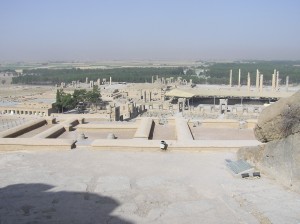Tehran and departure
I spent the final weeks of my trip back in Tehran. However much I enjoyed my travels around the country, a part of me felt like I was returning home when my bus pulled into the Tehran terminus. Exhausted from living out of a suitcase and sightseeing, I spent this time mostly with my friends. Needless to say, time flew by much too fast and, before I knew it, it was time to say goodbye. I was stunned. Two months had seemed like a long time when I had boarded my flight to Tehran. Now I had to make most of every minute.
When I had booked my flight, it had turned out to be cheaper flying back to the West from Iran via India than via Europe, so Delhi was my next destination. Squeezed in between my parents in the back of our car on our way home from the airport, I couldn’t stop talking about my trip and still I would constantly interrupt myself with “This is nothing. There’s so much more.” In Delhi, I took an intensive course in Persian, building on what I had learned during my stay (Farsi and Hindi are even closer than I had thought).
Finally, I can’t think of words to do justice to my experiences and the profound sense of gratefulness I feel for being given this opportunity to travel to Iran. Who could be better suited to fill this vacuum than the great Persian Sufi poet Rumi, who, through various channels, has been with me since childhood?
Who sees inside from outside?
Who finds hundreds of mysteries
even where minds are deranged?
See through his eyes what he sees.
Who then is looking out from his eyes?
Esfahan
“Esfahan–Nesf-e Jahan” (Half the World), the “Florence of the Orient,” visited and eulogized by Robert Byron and Andre Malraux–Esfahan is nothing short of legendary. It was hard to keep my expectations sober as I embarked on the longest of my bus journeys from Shiraz to this city of marvels.
What I found there was indeed stunning. Naqsh-e Jahan Square, which includes Ali Qapu Palace (built by the Safavid king Shah Abbas), the Imam and Lotfallah Mosques, and the Bazaar-e Bozorg, is a UNESCO World Heritage Sight and breathtakingly beautiful.
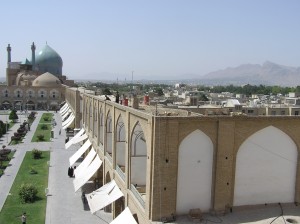
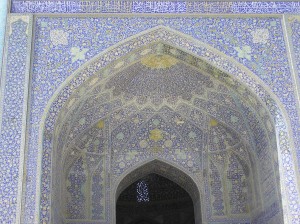
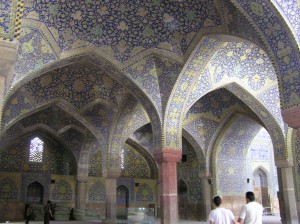
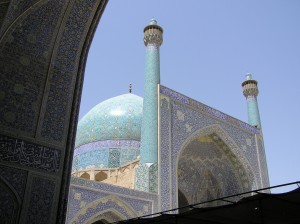
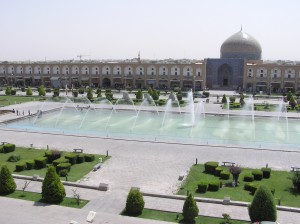
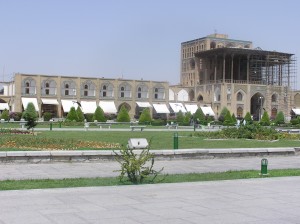
Esfahan is also famous for the bridges that cross the Zayande river. Sio-Seh Pol and Khaju Bridge were both built by Safavid rulers.
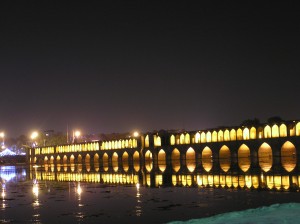
This picture shows the iconic Sio-Seh Pol, known as such because of its thirty-three (“sio-seh”) arches.
Other highlights included Chehel Sotun Palace and Vank Cathedral in the middle of Jolfa, the Armenian quarter.
Persepolis
It blew my socks off. I had high expectations from it and reading the history in more detail in the weeks that went before had me excited about visiting the ancient ruins. Yet I told myself that they were just ruins, that I would be disappointed if I hyped them too much. But no hype can do justice to the magnificence of this site, especially when visited early in the morning as I did.
An hour’s drive away from Shiraz, I watched the sun rise above the pillars, gateways, sculptures, and relief walls that are left today. I climbed the steep hill behind it and looked out over the ruins and the landscape below. The city, the symbolic capital of the Achaemenid Empire, was built on an elevated site so one could see the stone columns inlaid with gold, silver, and precious stones glistening in the sun from far away. The relief walls, some still standing today, show scenes of kings from all corners of the empire arriving bearing gifts and paying homage to the emperor. The on-site museum shows pieces with cuneiform inscriptions, some of which I had already seen at the National Museum in Tehran. From its inception to construction and expansion, Persepolis encompassed the reigns of the three Persian emperors Cyrus, Darius, and Xerxes (all of them known as “the Great”). It was destroyed when Alexander the Great conquered Persia. The most widely-accepted theory states that Alexander set fire to Persepolis to avenge the burning down of the Acropolis in Athens, but there are other claims asserting that the fire, traces of which can be clearly seen on the stone even today, was an accident.
On the way back to Shiraz we stopped to see the Achaemenid tombs at Naqsh-e Rostam and Naqsh-e Rajab.
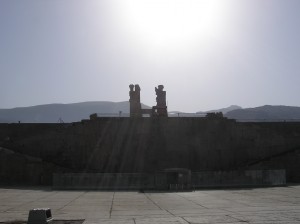
The entrance to Persepolis

The entrance to Persepolis

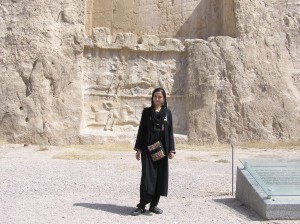
In front of the tombs at Naqsh-e Rostam
Shiraz
I left Yazd early for Shiraz. The bus ride took about six hours through desert and hills. I was looking forward to Shiraz, which is known first and foremost as having spawned the poets Sa’adi and Hafez. Shiraz is also the capital of the province called Fars, from which the name Persia is derived. In other words: I’m entering ur-Iranian territory, the birthplace of what was once the largest empire in the world.
The first evening I headed straight to Hafez’s tomb. I was told it never used to be so crowded, full of youngsters jostling for drinks and a snack at the newly-built coffee shop. Despite the crowds, and maybe partly because of them, there was a certain lively serenity at the site that I appreciated after the long hours on the road and that arguably stayed true to the spirit of his poetry. Later that evening I had dinner with some friends of friends at a fast food joint. Our menu: grilled chicken, French fries, cole slaw, and fried mushrooms.
Shiraz was much bigger than Kashan and Yazd and I felt the difference after Tehran, where public transportation is very good. In Shiraz I resorted to taxis most of the time. It didn’t strike me as a pedestrian-friendly city–unless you have a fondness for young dudes grazing you with their motorcycles on the pavement. I also changed my hotel once, which was a good decision, because in time for the Germany-Argentina match it turned out that my new hotel’s staff were all ardent followers of the World Cup, so I spent a very memorable evening with them in front of the TV in the lobby, which we transformed into our very own sport’s bar, celebratory ice cream and all.
Among the other highlights in Shiraz were the three mosques–Vakil, Nasir-al Mulk, and the beautiful and restored 9th century Atigh Mosque–the tomb of Sa’adi with its garden and fish ponds, the Arg-e Karim Khan, a citadel-turned-museum built by the Zand rulers (18th c.), the Armenian church, and the stunning Bagh-e Eram, the botanical gardens.
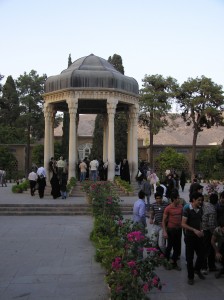
Hafez's Tomb
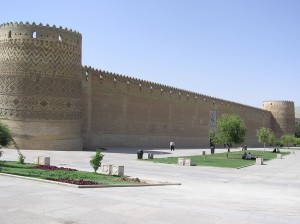
Arg-e Karim Khan
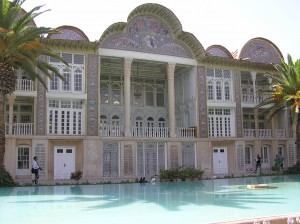
Bagh-e Eram

The gate to the city of Shiraz
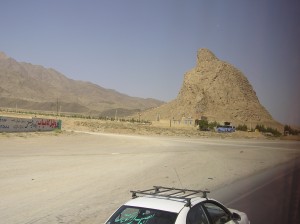
A rock formation known popularly for its hawk-like shape en route from Yazd to Shiraz
Yazd
From Kashan to Yazd I took a train. I knew that I’d be traveling by bus the rest of my trip–Iran has an excellent bus system–but I had heard about the train connection between the two cities and was eager to try a different mode of transportation. It was great! The conductor took very good care of me once he realized I didn’t speak the language. He found me a compartment with two nice ladies whom I befriended over the next five hours with the help of gestures and my rudimentary Persian (thank you to the inventor of phrasebooks!).
Outside of Tehran, Yazd was probably my favorite city that I visited in Iran, even though it was also the hottest. There is something very serene about this city deep in the desert that is reflected in the architecture: most buildings are low and made from beige clay bricks. As in Kashan, in Yazd, too, the architects and engineers developed ingenious ways of storing the two most important resources in the desert–water and cool air. When you climb to the top of the Amir Chakhmakh complex at the center of Yazd, you see beige towers peeking out all over the city. These are badgirs, wind-catching towers that channel the air through a shaft and cool it just by keeping the air flow steady (some are also linked to underground water canals called qanats). I visited the Daulatabad badgir which is known as one of the tallest ones standing. When I stood directly below it, the wind was so strong it blew my hair back.
Though the Jame Mosque in Yazd is very beautiful, Yazd is famous for its Zoroastrian population, which has thrived in the area for thousands of years. I visited the main temple in Yazd, as well as the two Towers of Silence on the edge of the city where Zoroastrians used to lay their dead (a sight and concept familiar to me from Mumbai).
What I loved about Yazd, in the end, was that there was a lot to discover, yet, it was small enough that I could wander around by foot and discover the city leisurely, without having to consult my map too often or resorting to taxis. The bazaar in Yazd was a lot of fun, too, very laid-back and friendly, and the food all over town was excellent.
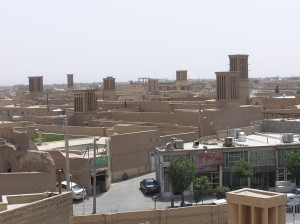
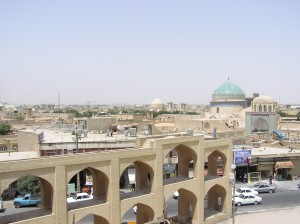
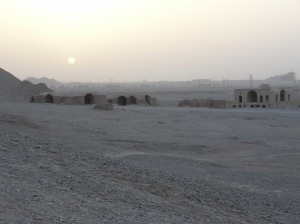
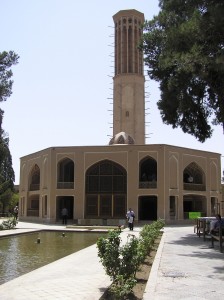
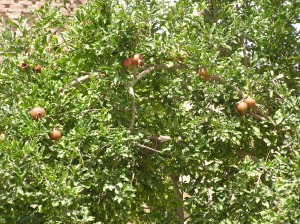
Kashan
Kashan is about half-way between between Tehran and Yazd, some four hours by bus. It is a small town, much smaller than Esfahan or Shiraz, and it’s known for its old, palatial houses that were built for the important trading families back when Kashan was a key trading center. These houses can be visited today as a sample of traditional Iranian architecture. They are fascinating for their intricate but expansive lay-out and ingenuity in using readily-available resources–air, some water, trees, gravity–in creating complex systems of cooling, ventilation, and water circulation.
Until today, Kashan is an oasis city in the middle of the desert. Remnants of a very old civilization, dating back at least 8,000 years, can still be found there today at an archaeological site called Sialk. I saw some of the findings from that site at the National Museum in Tehran, but I read that they are also at the Louvre. Even though I visited the site at dusk it was incredibly hot, and the highlight of the evening was dipping my feet into a water channel at the beautiful, legendary Fin Garden, built by the Safavid kings. Of course, the real highlight was watching Germany beat England that night 4-1!
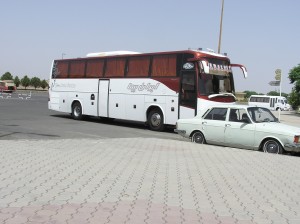
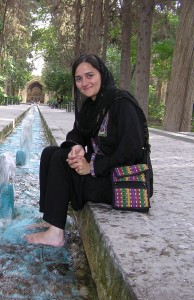


Tehran
I made my most important discovery in Tehran on day 2: bus # 7. It goes up and down the main road of Tehran, which I was told is the longest in the Middle East: Vali-Asr Street. Once I figured out the ticketing system, I had my routine: hop on the bus in the morning either heading north towards Vanak and Taijrish or south towards Vali-Asr Square and explore different parts of the city until lunch-time, after which it was simply too hot. Stay indoors until about five and then head out again. In this way I saw the following places, among others: the National Museum, Golestan Palace, the Tehran Bazaar, Imam Khomeini Mosque, the Film Museum, the Glass Museum, Si-e Tir Street with its mosque, Zoroastrian Temple, synagogue and church, Laleh Park, Gandhi Street and the up-scale Jam-e Jam Mall, Tehran University and Engelab Avenue with its bookstores, Khan-e Honar (”Artists’ House). These were just the sights, but most of the time I would take the bus for a while and then walk around the city until I got tired. I loved going on those walks and stumbling on a little park or cafe or bookshop somewhere. Wherever I went, it was easy to meet people. Everyone was extremely friendly and curious and, in general, spoke English reasonably well. I also took the metro a few times, most importantly to visit Shar-E Rey, the original settlement that dates back about eight thousand years and which today is part of South Tehran, which is less affluent and more conservative than the north.
Here are some impressions:
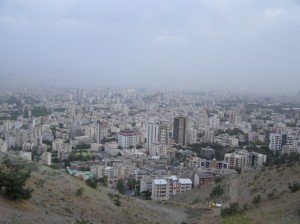
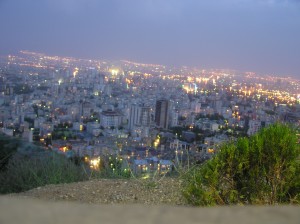
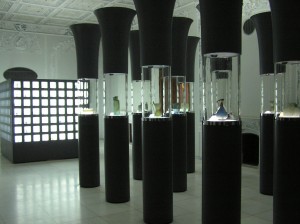
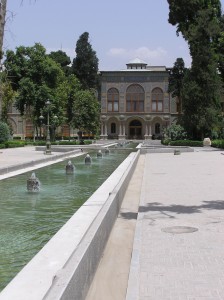

Arrival in Iran
The spectacle over the city as the plane descended in the middle of the night was beautiful: at eye-level more stars than I had seen in a long time, and below the sprawling lights of Tehran. I remember feeling a strong tickle in my stomach–I was dying to find out what I would find among those lights and the lights beyond–in those legendary and extraordinary places whose contemporaneity I had set out to discover. My plan was to stay in Tehran for a week, then travel on to Yazd, Shiraz/Perspepolis, and Esfahan, staying a couple of weeks in each place. What I ended up doing was spending the longest time–several weeks–in Tehran, a fascinating, vibrant city, staying on average a week in each of the other cities, and adding Kashan to that list.
Since I am writing this in retrospect, I will not go strictly chronologically. I do have to start with my first day, though. My host family in Tehran, arguably the loveliest people I’ve ever met, had invited some friends over for lunch, which is more accurately described as a five-hour feast.
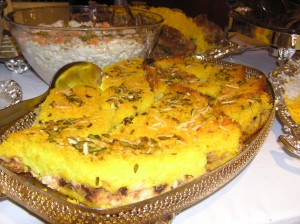
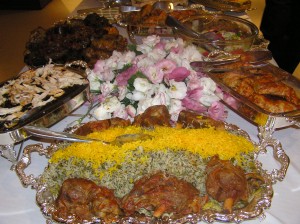
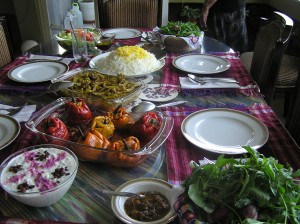

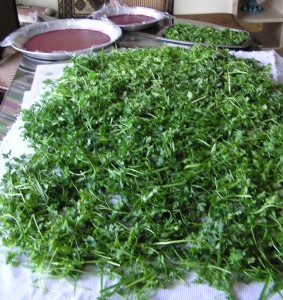
April 28, 2010
 This summer I plan to visit Iran, which has captured my imagination for as long as I can remember. I have a long-standing personal interest in tracing the influences other cultures have had on India, where my writing is set and from where I derive most of my material. So far, I have only encountered Persian culture through its various manifestations (artistic, linguistic, historical, cultural, religious) in India. By understanding how our histories, cultures, languages, and daily routines all hang together (or don’t), I hope to sharpen my perception, learn many new things, and become a better writer. I plan to live in Iran for two months this summer, seeing the sights, meeting people, and learning the language. I hope to visit Tehran, Esfahan, Yazd, Shiraz, Persepolis, Tabriz, and some of the surrounding areas.
This summer I plan to visit Iran, which has captured my imagination for as long as I can remember. I have a long-standing personal interest in tracing the influences other cultures have had on India, where my writing is set and from where I derive most of my material. So far, I have only encountered Persian culture through its various manifestations (artistic, linguistic, historical, cultural, religious) in India. By understanding how our histories, cultures, languages, and daily routines all hang together (or don’t), I hope to sharpen my perception, learn many new things, and become a better writer. I plan to live in Iran for two months this summer, seeing the sights, meeting people, and learning the language. I hope to visit Tehran, Esfahan, Yazd, Shiraz, Persepolis, Tabriz, and some of the surrounding areas.
